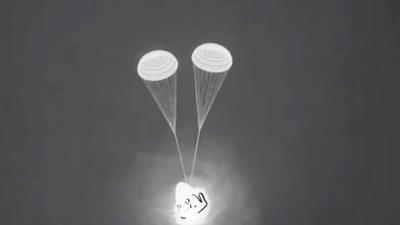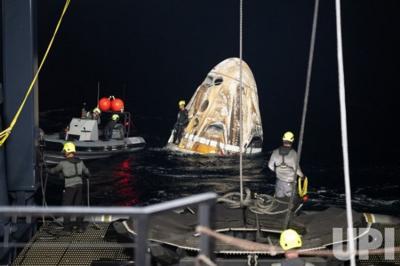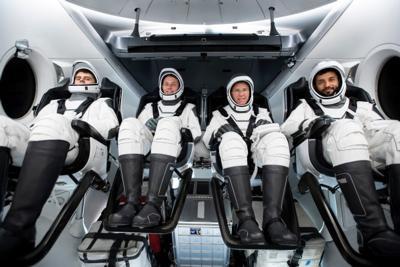Tales from the Florida-ISS Express
The splashdown of the SpaceX Crew Dragon capsule dubbed Endeavour marked the successful end of NASA’s SpaceX Crew-6 mission.

The capsule drifted safely down under a quartet of fully-deployed parachute canopies, plunging—hot and bearing the scorched scars of atmospheric re-entry—into the cold waters off the Atlantic coast of Jacksonville, Florida at 00:17 EDT.
Teams aboard SpaceX maritime recovery vessels retrieved the spacecraft and its crew and returned men and machine to shore. The crew was subsequently flown to NASA’s Johnson Space Center in Houston for debriefing.
Crew-6—as denoted by the appellation—was NASA’s sixth commercial crew-rotation mission to the International Space Station (ISS). The crew—NASA astronauts Stephen Bowen and Woody Hoburg, UAE (United Arab Emirates) astronaut Sultan Alneyadi, and Roscosmos cosmonaut Andrey Fedyaev—spent a total of 186-days in orbit.
NASA Administrator Bill Nelson stated: “After spending six months aboard the International Space Station, logging nearly 79-million-miles during their mission, and completing hundreds of scientific experiments for the benefit of all humanity, NASA’s SpaceX Crew-6 has returned home to planet Earth. This international crew represented three nations, but together they demonstrated humanity’s shared ambition to reach new cosmic shores. The contributions of Crew-6 will help prepare NASA to return to the Moon under Artemis, continue onward to Mars, and improve life here on Earth.”

The Crew-6 mission departed for the ISS on 02 March 2023, lifting off from NASA’s Kennedy Space Center at 00:34 EST. Strapped securely into the Endeavour Crew Dragon capsule, the four spacefarers blasted heavenward atop a SpaceX Falcon 9 rocket, docking some 25-hours later to the space-facing port of the ISS’s Harmony module.
On 06 May, the Crew-6 personnel completed a port relocation maneuver to the Earth-facing port ahead of the arrival of a SpaceX Cargo Dragon spacecraft carrying new solar arrays, scientific apparatus, and supplies to the space station.
Over the course of the Crew-6 mission, Bowen, Hoburg, Alneyadi, and Fedyaev traveled 78,875,292-miles, completing 2,976 orbits of the Earth. The space-flight was Hoburg’s, Alneyadi’s, and Fedyaev’s First. Bowen, conversely, has logged a total of four space-flights totaling 227 days beyond Earth’s surly bonds.
While aboard the ISS, the Crew-6 personnel conducted scientific and station maintenance activities as well as technology demonstrations. For purpose of installing a pair of new International Space Station Roll-Out Solar Arrays (IROSAs) intended to augment the station’s power generation capacity, Bown undertook three spacewalks, joined by Hoburg for two and Alneyadi for one.
In addition to studying botanical genetic adaptations to space, and monitoring human physiological response to microgravity, the astronauts released Saskatchewan’s first satellite—a clever contraption designed to test a new radiation detection and protection system derived from one of the five basic types of melanin, the pigment found in most Earthly organisms.
The Crew-6 mission’s return flight to Earth commenced with Endeavour undocking from the ISS at 07:05 EDT on the morning of Sunday, 03 September. After moving away from the space station by way of a series of departure burns, Endeavour executed multiple orbit-lowering maneuvers, re-entering Earth’s atmosphere and splashing down some 17-hours later.

In serendipitous and wholly-coincidental emulation of Bowen, the Crew-6 mission occasioned Endeavour’s fourth space-flight. Following splashdown, the veteran spacecraft was returned to SpaceX’s refurbishing facility on Cape Canaveral Space Force Station, where engineers and technicians will inspect it, analyze telemetry data gathered over the Crew-6 mission, and prepare the vessel for its next flight. Endeavour’s return to Earth was preceded by the launch of NASA’s SpaceX Crew-7 mission, which docked to the ISS on 27 August.
The Crew-6 mission is a component of NASA’s Commercial Crew Program, an agency initiative which seeks to establish and maintain safe, reliable, and cost-effective transportation to and from the ISS and Low Earth Orbit (LEO).
 ANN's Daily Aero-Linx (05.06.25)
ANN's Daily Aero-Linx (05.06.25) ANN's Daily Aero-Term (05.06.25): Ultrahigh Frequency (UHF)
ANN's Daily Aero-Term (05.06.25): Ultrahigh Frequency (UHF) ANN FAQ: Q&A 101
ANN FAQ: Q&A 101 Classic Aero-TV: Virtual Reality Painting--PPG Leverages Technology for Training
Classic Aero-TV: Virtual Reality Painting--PPG Leverages Technology for Training Airborne 05.02.25: Joby Crewed Milestone, Diamond Club, Canadian Pilot Insurance
Airborne 05.02.25: Joby Crewed Milestone, Diamond Club, Canadian Pilot Insurance





